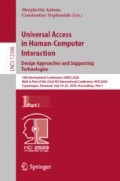Abstract
Cultural heritage sites (museums, archaeological parks, exhibition spaces, etc.) do not always guarantee accessibility to all users, regardless of their abilities. Often services are not really as usable and functional as expected. Currently there is no website offering accessibility information on heritage sites in a format accessible to all. People with disability or their caregivers are forced to spend considerable time and effort to obtain accessibility information, sometimes encountering difficulties. The Axem portal aims to fill this gap by offering information on the degree of accessibility of cultural sites (museums, archaeological parks, libraries, art galleries, places of worship, exhibition spaces, etc.). It has been designed as a facility for people with disabilities and in general for all individuals who have special needs and require specific services. In this paper the Axem web site is presented as a case study to (1) investigate the use of web techniques for enhancing screen reading interaction, and (2) propose a portal to collect information on accessible services supported by the cultural sites. Regarding web accessibility, the use of WAI ARIA, an accessible web design, is discussed in order to improve screen reading interaction. Accessibility functions and features as well as the ranking algorithm for easy search and the rating mechanism are presented. This work offers a further contribution to the web accessibility field, while proposing a portal which could be exploited by cultural heritage sites and promote their accessible services to people with disability.
Access this chapter
Tax calculation will be finalised at checkout
Purchases are for personal use only
References
WHO 2019: World Health Organization. Report on disability. https://www.who.int/disabilities/world_report/2011/report/en/. Accessed 10 Oct 2019
D’Agnano, F., Balletti, C., Guerra, F., Vernier, P.: Tooteko: a case study of augmented reality for an accessible cultural heritage. Digitization, 3D printing and sensors for an audio-tactile experience. Int. Arch. Photogramm. Remote Sens. Spat. Inf. Sci. 40(5), 207 (2015)
Karimi, R., Nanopoulos, A., Schmidt-Thieme, L.: RFID-enhanced museum for interactive experience. In: Grana, C., Cucchiara, R. (eds.) MM4CH 2011. CCIS, vol. 247, pp. 192–205. Springer, Heidelberg (2012). https://doi.org/10.1007/978-3-642-27978-2_17
Ghiani, G., Leporini, B., Paterno, F.: Supporting orientation for blind people using museum guides. In: CHI 2008 Extended Abstracts (2008)
Asakawa, S., et al.: An independent and interactive museum experience for blind people. In: Proceedings of the 16th Web For All 2019 Personalization-Personalizing the Web, p. 30. ACM (May 2019)
Rossetti, V., Furfari, F., Leporini, B., Pelagatti, S., Quarta, A.: Enabling Access to cultural heritage for the visually impaired: an interactive 3D model of a cultural site. Procedia Comput. Sci. 130, 383–391 (2018)
Dindler, C., Iversen, O.S., Smith, R., Veerasawmy, R.: Participatory design at the museum: inquiring into children’s everyday engagement in cultural heritage. In: Proceedings of the 22nd Conference of the Computer-Human Interaction Special Interest Group of Australia (OZCHI 2010), pp. 72–79. ACM, New York (2010)
Buzzi, M.C., Buzzi, M., Leporini, B., Marchesini, G.: Improving user experience in the museum. In: Proceedings of the IADIS—Interfaces and Human Computer Interaction, pp. 327–331 (2013)
Buzzi, M.C., Buzzi, M., Leporini, B., Mori, G., Penichet, V.M.R.: Accessing Google docs via screen reader. In: Miesenberger, K., Klaus, J., Zagler, W., Karshmer, A. (eds.) ICCHP 2010. LNCS, vol. 6179, pp. 92–99. Springer, Heidelberg (2010). https://doi.org/10.1007/978-3-642-14097-6_17
Buzzi, M., Leporini, B.: Editing Wikipedia content by screen reader: easier interaction with the Accessible Rich Internet Applications suite. Disabil. Rehabil.: Assist. Technol. 4(4), 264–275 (2009)
Chiang, H.H., Tsaih, R.H., Han, T.S.: Measurement development of service quality for museum websites displaying artifacts. In: Managing Innovation and Cultural Management in the Digital Era, pp. 100–127. Routledge (2016)
Falk, J.H., Dierking, L.D.: Learning from Museums. Rowman & Littlefield, Lanham (2018)
Bohnert, F., Zukerman, I.: Non-intrusive personalisation of the museum experience. In: Houben, G.-J., McCalla, G., Pianesi, F., Zancanaro, M. (eds.) UMAP 2009. LNCS, vol. 5535, pp. 197–209. Springer, Heidelberg (2009). https://doi.org/10.1007/978-3-642-02247-0_20
Partarakis, N., Klironomos, I., Antona, M., Margetis, G., Grammenos, D., Stephanidis, C.: Accessibility of cultural heritage exhibits. In: Antona, M., Stephanidis, C. (eds.) UAHCI 2016. LNCS, vol. 9738, pp. 444–455. Springer, Cham (2016). https://doi.org/10.1007/978-3-319-40244-4_43
Kabassi, K.: Evaluating websites of museums: state of the art. J. Cult. Herit. 24, 184–196 (2017)
Fotakis, T., Economides, A.A.: Art, science/technology and history museums on the web. Int. J. Digit. Cult. Electron. Tour. 1(1), 37–63 (2008)
Alletto, S., et al.: An indoor location-aware system for an IoT-based smart museum. IEEE Internet Things J. 3(2), 244–253 (2015)
Carrozzino, M., Bergamasco, M.: Beyond virtual museums: experiencing immersive virtual reality in real museums. J. Cult. Herit. 11(4), 452–458 (2010)
Anagnostakis, G., et al.: Accessible museum collections for the visually impaired: combining tactile exploration, audio descriptions and mobile gestures. In: Proceedings of the 18th International Conference on Human-Computer Interaction with Mobile Devices and Services Adjunct, pp. 1021–1025. ACM (September 2016)
W3C: WCAG 2.1 1.1. https://www.w3.org/TR/WCAG21/
W3C: WAI-ARIA 1.1. https://www.w3.org/TR/graphics-aria-1.0/#bib-wai-aria-1.1
Leporini, B., Paternò, F.: Applying web usability criteria for vision-impaired users: does it really improve task performance? Int. J. Hum.-Comput. Interact. 24(1), 17–47 (2008)
Author information
Authors and Affiliations
Corresponding author
Editor information
Editors and Affiliations
Rights and permissions
Copyright information
© 2020 Springer Nature Switzerland AG
About this paper
Cite this paper
Buzzi, M., Leporini, B., Romano, F. (2020). Exploring WAI-Aria Techniques to Enhance Screen Reader Interaction: The Case of a Portal for Rating Accessibility of Cultural Heritage Sites. In: Antona, M., Stephanidis, C. (eds) Universal Access in Human-Computer Interaction. Design Approaches and Supporting Technologies. HCII 2020. Lecture Notes in Computer Science(), vol 12188. Springer, Cham. https://doi.org/10.1007/978-3-030-49282-3_17
Download citation
DOI: https://doi.org/10.1007/978-3-030-49282-3_17
Published:
Publisher Name: Springer, Cham
Print ISBN: 978-3-030-49281-6
Online ISBN: 978-3-030-49282-3
eBook Packages: Computer ScienceComputer Science (R0)

